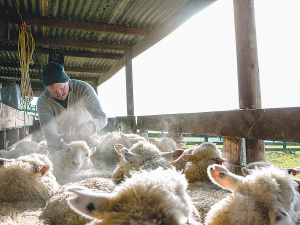NZ scientists make breakthrough in Facial Eczema research
A significant breakthrough in understanding facial eczema (FE) in livestock brings New Zealand closer to reducing the disease’s devastating impact on farmers, animals, and rural communities.
 The trial looked at look at the management of replacement ewe lambs and how genes influence feed efficiency and resilience to animal health challenges.
The trial looked at look at the management of replacement ewe lambs and how genes influence feed efficiency and resilience to animal health challenges.
Beef + Lamb New Zealand Genetics' Low Input Sheep Progeny Trial is identifying the genetics that will future-proof this country's sheep industry.
In part two of this series we look at the management of replacement ewe lambs in the trial and how genes influence feed efficiency and resilience to animal health challenges.
Over autumn and winter, the ewe lambs are shorn and fleece traits recorded. They are run through Portable Accumulation Chambers to measure their methane production (another heritable trait).
In July and August, a representative sample is sent to Invermay where each animal is tested for residual feed intake – looking at which animal makes the most efficient and effective use of feed resources.
All ewe lambs are retained and while they had reached 40kg by May, they are not mated, although a teaser ram is run with them to identify which lambs are cycling. Last year, 70% of the ewe lambs cycled.
In March of this year, the two-tooths weighed 67kg and Robert Peacock says they were amongst the best two-tooths he has seen. This is despite none being culled – as would be standard practice.
He says, genetically, there is a big difference between studs, and this reflects the length of the time each stud has been focusing on traits such as worm resistance and dags.
“The genetics work, but it is a slow game, you just can’t put your drench gun away overnight.”
Peacock says the results have shown that no one ram is good at every trait and no one breed is good at every trait.
“The more traits you select for, the slower you will go.”
Dags, for example, are heritable and breeders can move quite quickly to breed those out, but there may be a penalty with slower wool growth. However, getting rid of dags will potentially stop flystrike and the need to dip lambs.
Meanwhile, Peacock believes the industry would need five to ten years notice if it were to stop tailing.
“It will take a while, but it’s certainly do-able.”
While consumers are increasingly demanding lamb produced without chemicals, Peacock believes widespread drench resistance – including triple drench resistance – will force the industry into farming without the use of drenches long before regulations will.
“Farmers will be forced into a corner.”
Speaking at the field day were three AgResearch scientists, Kathryn McRae, Suzanne Rowe and Tricia Johnson, all involved in some aspect of the Low Input Progeny Trial.
McRae talked about using genetic improvement to provide a better product for consumers, produced with less impact on the environment.
McRae says individual sheep differ in their ability to develop resistance to parasites, and Worm- FEC is a breeding value – or measure of resistance to parasites.
This is poorly genetically correlated with dagginess.
While faecal egg counts (FEC) are still the best proxy for parasite burdens and a tool to measure an animal’s resistance to parasites, DNA will be used in the future to look at parasite species at the same time as FECs.
Scientists will also be looking at the impact of parasites on behaviour and the interaction between the faecal microbiome and internal parasites.
Pneumonia is found in 30-40% of all lambs at slaughter. It costs the industry millions of dollars every year in lost performance.
McRae says it is possible to breed animals that are less susceptible to pneumonia and it appears there is possibly a positive genetic correlation between FECs and pneumonia, but that has yet to be validated.
Interestingly, animals with lung lesions grow faster from birth to weaning but slower from weaning to slaughter than animals without lesions.
The heritability of a pneumonia lesion score is 0.07-0.16, which shows that genetic gains can be made.
Facial eczema is a production- limiting disease expected to move further south with climate change. RamGuard is the commercial testing programme for tolerance to facial eczema (FE). Tolerance to FE is heritable (0.45) and there appears to be a positive genetic correlation between FE and FEC.
More Wool, Less Methane
AgResearch's Suzanne Rowe outlined the work that has gone into identifying and breeding low methane producing sheep.
There is an average 11% difference in the methane production of high and low methane producing sheep.
However, while the team at AgResearch have measured for everything, they have found no correlation between any trait except wool growth. Low methane sheep produce slightly more wool.
Portable Accumulation Chambers (PAC) are used to measure an individual animal’s methane production and are being used in stud flocks around the country.
“There is a lot of variation within flocks which is exciting as it means we can select low methane animals,” Rowe explains.
Farmer confidence has taken a slight dip according to the final Rabobank rural confidence survey for the year.
Former Agriculture Minister and Otaki farmer Nathan Guy has been appointed New Zealand’s Special Agricultural Trade Envoy (SATE).
Alliance Group has commissioned a new heat pump system at its Mataura processing plant in Southland.
Fonterra has slashed another 50c off its milk price forecast as global milk flows shows no sign of easing.
Meat processors are hopeful that the additional 15% tariff on lamb exports to the US will also come off.
Fears of a serious early drought in Hawke’s Bay have been allayed – for the moment at least.